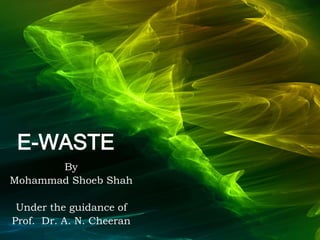
E waste
- 1. E-WASTE By Mohammad Shoeb Shah Under the guidance of Prof. Dr. A. N. Cheeran
- 2. CONTENTS Definition E-waste in daily life E-waste concerns worldwide E-waste in India E-waste in Indian cities Environmental Hazards Effects on human health E-waste management Regulations and Laws Technology used in management of E-waste by companies.
- 3. WHAT IS E-WASTE ?
- 4. E-Waste ? A broad and growing range of electronic devices ranging from large household devices such as Refrigerators , ACs, Cell phones, Computers, Laptops, T.V and all consumer electronics which have been discarded by their users. According to Sinha- Khetriwal , “e-Waste can be classified as any electrical powered appliance that has reached its end-of-life”.
- 5. Sources of E-Waste: Home: • PC • Television • Radio • Cell phones • Washing machine • Microwave oven • CD player • Fan • Electric Iron • etc Hospitals: • PC • Monitors • ECG device • Incubator • etc Government • PC • CPU • FAX machine • Xerox machine • Scanner • Fan • Tube lights • Air condition s etc Private Sectors (Restaurants , Industries): • PC • Boilers • Mixer • Signal Generators • Incubator • etc
- 8. In the United States (US)market, less than 80 million communication devices were sold in 2003; the number exceeded 152 million by 2008 , a growth of over 90 percent in 5 years. Meanwhile, in 2006, more than 34 million TVs have been exposed in the market, and roughly 24 million PCs and 139 million portable communication devices have been produced. In the European Union (EU), the total units of electronic devices placed on the market in 2009 were more than 3.8 billion units, including 265 million computers, roughly 245 million in home consumer electronics. In China, approximately 20 million refrigerators and more than 48 million TVs were sold in 2001, and nearly 40 million PCs were sold in 2009 [6]. Furthermore, the growth rate is increasing every year
- 10. Estimated the total number of Personal Computers (PCs) emanating each year from business and individual households in India will be around 1.38 million, according to a report of confederation of Indian industries, the total waste generated by obsolete electronic and electrical equipment (EEE) in India has been estimated to be 146,000 tons per year. In case of TV, it varied from 1.07 to 1.78 and for mobile phones it varied from 0.88 to 1.70. the low income households use the PC for 5.94 years, TV for 8.16 years and the mobile phones for 2.34 years while, the upper class income uses the PC for 3.21 years, TV for 5.13 years and mobile phones for 1.63 years. The growth rate of the mobile phones 80% is very high compared to PC 20% and TV 18%.
- 13. Hazards To Environment and Human Health
- 14. Compared to conventional municipal wastes, certain components of electronic products contain toxic substances, which can generate a threat to the environment as well as to human health. For instance, television and computer monitors normally contain hazardous materials such as lead, mercury, and cadmium, while nickel, beryllium, and zinc can often be found in circuit boards. As more e-Waste is placed in landfills, exposure to environmental toxins is likely to increase, resulting in elevated risks of cancer and developmental and neurological disorders. Personal computers (PCs) contain certain components, which are highly toxic, such as chlorinated and brominated substances, toxic gases, toxic metals, biologically active materials, acids, plastics and plastic additives. Circuit boards containing heavy metals like lead & cadmium; batteries containing cadmium; cathode ray tubes with lead oxide & barium; brominated flame retardants used on printed circuit boards, cables and plastic casing; (PVC) coated copper cables and plastic computer casings that release highly toxic dioxins & furans when burnt to recover valuable metals; mercury switches; mercury in flat screens; poly chlorinated biphenyl's (PCB's) present in older capacitors; transformers; etc.
- 15. Source of e-wastes Constituent Health effects Solder in printed circuit boards, glass panels and gaskets in computer monitors Lead (PB) •Damage to central and peripheral nervous systems, blood systems and kidney damage. •Affects brain development of children. Chip resistors and semiconductors Cadmium (CD) •Toxic irreversible effects on human health. •Accumulates in kidney and liver. •Causes neural damage. •Teratogenic. Relays and switches, printed circuit boards Mercury (Hg) •Chronic damage to the brain. •Respiratory and skin disorders due to bioaccumulation in fishes. Cabling and computer housing Plastics including PVC Burning produces dioxin. It causes •Reproductive and developmental problems; •Immune system damage; •Interfere with regulatory
- 17. International Laws of E-Waste European Union (EU) restriction of the use of certain hazardous substances in electrical and electronic equipment Similar e-Waste legislation has been introduced in China and other countries as well. For instance, China has established administrative measures to control the pollution of WEEE. Meanwhile, several multinational collaboration agreements are currently taking shape to prohibit or limit the shipment of hazardous waste, including e-Waste, from industrialized to developing counties No dumping toxic e-waste in developing countries. No use of prison labor in electronics recycling. No disposal of e-waste in landfills or incinerators, including waste- to- energy incinerators.
- 18. Rules in INDIA 1. Hazardous Wastes (Management and Handling) Rules, 1989/2000/2002 2. MoEF Guidelines for Management and Handling of Hazardous Wastes,1991 3. Guidelines for Safe Road Transport of Hazardous Chemicals,1995 4. The Public Liability Act, 1991 5. Batteries (Management and Handling) Rules, 2001 6. The National Environmental Tribunal Act, 1995 7. Bio-Medical Wastes (Management and Handling) Rules, 1998
